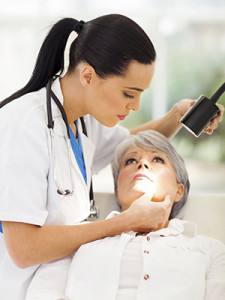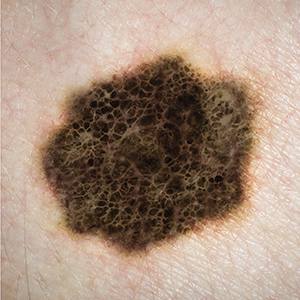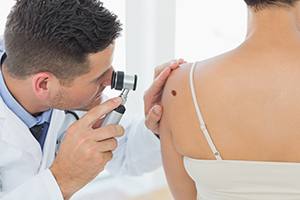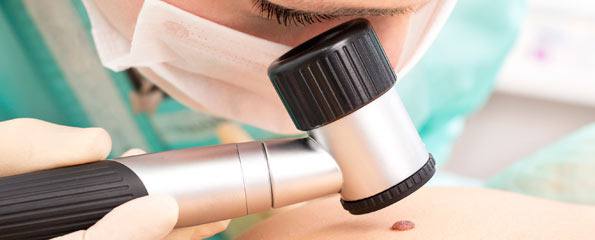Skin checks and skin clinics
- Skin checks
- Finding the right skin clinic
- Finding the right specialist
- How often should a skin check be performed?
- What doctors look for when performing a skin check
- What does a skin check involve?
- Management of a suspicious lesion
- How much does a skin check cost?
- References
Fast facts about skin checks and skin clinics
- Skin checks are performed to identify skin cancer. They can be performed by yourself (self examination) or by a doctor. How often this occurs depends on your risk of developing skin cancer.
- When choosing a skin clinic to have your skin check it’s important to consider the qualifications of staff, cost, information and follow-up as well as waiting times and location of the clinic.
- When performing a skin check for an adult, doctors look for skin changes and moles or freckles with unusual features such as asymmetry, irregular borders, botchy colour or increasing size.
- When performing a skin check for a child, doctors look for new moles or freckles with unusual features including uniform red/pink coloured freckles or moles which are bleeding or bumpy moles.
- During a skin check your doctor will examine your entire skin surface, including areas not usually exposed to sunlight. They may measure the size of moles or freckles.
- The doctor may also examine suspicious spots using a hand held microscope called a dermatoscope.
- Photographs of suspicious moles or your entire skin surface may also be taken.
- If your doctor identifies a suspicious mole, it may be biopsied.
- The cost of a skin check varies depending on the doctor and clinic.
Skin checks
Skin checks for melanoma and other types of skin cancer at clinics or doctors’ offices are not performed regularly like checks for other types of cancer (e.g. pap smears for cervical cancer). Instead they are performed when a person asks their doctor (e.g. because they notice a suspicious mole), or when a doctor identifies a patient that may require a skin check (e.g. someone who is at high risk because of their work and history). How often this should be done varies depending on the patient’s risk.
There are some people that are more likely to attend for a skin check. These include people with fair skin aged 40-49, those who have had a skin cancer before and those who perceive they are personally at risk of skin cancer. People who ask their doctor for a skin check tend to have higher levels of education and often have concerns about suspicious skin changes which they identified through skin self-examination. General practitioners are often the first point of call for patients in need of skin examination and perform the majority of skin cancer checks. There are also a growing number of specialised skin cancer clinics available to attend in Australia.
Finding the right skin clinic
 There are a growing number of skin clinics in Australia and numerous factors to consider when choosing the right clinic to visit for a skin check, or assessing whether or not attending a specialist skin clinic offers any benefits over a general practitioner visit. It is important to be aware that many specialist skin clinics are run by general practitioners, not dermatologists (doctors who specialise in disorders of the skin).
There are a growing number of skin clinics in Australia and numerous factors to consider when choosing the right clinic to visit for a skin check, or assessing whether or not attending a specialist skin clinic offers any benefits over a general practitioner visit. It is important to be aware that many specialist skin clinics are run by general practitioners, not dermatologists (doctors who specialise in disorders of the skin).
Staff qualifications
The qualifications and experience of the doctor examining the skin are important. For the initial assessment of a suspicious skin lesion, visiting your general practitioner is recommended. Your general practitioner is best placed to make the examination because they are familiar with your medical history. Your general practitioner can refer onto a specialist if this is required. You can ask your doctor for a referral to a specialist if you are unsure and would like a second opinion on the diagnosis, even if your doctor does not recommend a specialist appointment.
Other factors
Other factors which may influence your choice of skin cancer clinic include:
- Cost, for example whether the cost is partially or wholly covered by Medicare, the cost of initial and ongoing treatments and diagnostic tests and the cost of travel to and from the clinic;
- Waiting time, which at some clinics (e.g. those that bulk bill services) may be too long if you have particularly concerning lesions. However your general practitioner may be able to arrange an urgent appointment if you have a suspicious lesion which requires urgent attention;
- Area of residence and availability of specialists in the area. In regional areas without local specialists, referring general practitioners may provide a list of nearby specialists and specialists who visit the area periodically.
Finding the right specialist
A number of specialists may be involved in the assessment and treatment of skin lesions. Most commonly these are dermatologists (skin specialists) and surgical oncologists (cancer specialists). The Australian Cancer Council provides a searchable directory of specialists that may be involved in skin cancer treatment.
How often should a skin check be performed?
The recommended frequency for examining your own skin (self examinations) or seeing a doctor for a skin check varies depending on your risk of skin cancer. Your risk depends on a number of risk factors that can be discussed with your general practitioner.
If you are at high risk it is recommended that you perform self examination every 3 months and have a full body examination with a doctor every 6-12 months. If you are medium risk it is recommended that you perform self examination every 3-6 months and have a full body examination with a doctor every 2-5 years. Low risk individuals are recommended to perform self examination every year (annually), with a once-off full body examination with a doctor to assess the risk as well as for advice regarding skin care.
Note that these are recommendations only. If you have not been taught by a doctor how to perform a self examination or you have a lesion you are concerned about, or just concerned in general and want to know how to minimise your risk, please make an appointment with your general practitioner to discuss this.
What doctors look for when performing a skin check
Changes to the skin are the key thing health professionals aim to identify through skin examination. Any new and/or changing skin lesions or lesions that you are worried about should be highlighted to your doctor. Changes the doctor will want to be informed of include, but are not limited to:
- Changes in the way the freckle or mole feels, for example it starts to be itchy;
- Changes in the appearance, including changes to the size, shape and/or colour of a mole or freckle;
- Lesions which rise up from the skin and begin crusting or bleeding.
These are the same changes you should look out for when examining your own skin.
Melanoma detection in adults
 There are several features that your doctor will be looking for to distinguish a melanoma from a mole, including:
There are several features that your doctor will be looking for to distinguish a melanoma from a mole, including:
- Asymmetry: They will note the shape and/or pattern of the lesion. A lesion that has an irregular shape or pattern is more likely to be a melanoma;
- Border: They will note the border of the lesion. The border or outline of a melanoma is usually irregular;
- Colour: Variation of colour within the lesion is an important sign as such lesions are more likely to be a melanoma;
- Diameter: Most melanomas are greater than 6 mm when first diagnosed. However, any lesions less than 6 mm of diameter that are suspicious should also be investigated;
- Evolving: Lesions that evolve (i.e. change in shape, size, surface, colour or symptoms such as itch) over time are more likely to be a melanoma.
One particular type of melanoma – nodular melanoma – can present quite differently and hence your doctor will also be looking for skin lesions that are elevated and firm to touch. Any nodule that has been growing for more than a month should be assessed as a matter of urgency.
Melanoma detection in children
Melanoma lesions in children usually look different to those in adults. A different set of ABCD criteria can be used to identify suspicious spots in children, which are typically:
- Amelanotic: They do not contain the pigment melanin and usually have a red or pink colour;
- Bleeding and bumpy: In children, melanoma spots are usually raised and may bleed;
- Colour: Melanoma in children usually has a uniform colour;
- Diameter: Melanoma lesions in children can vary in diameter but are often less than 6 mm.
What does a skin check involve?
A ‘skin check’ is a comprehensive assessment aimed at identifying any evidence of skin cancer. In addition to this, a skin check provides an opportunity to:
- Assess your individual risk;
- Provide education surrounding self-examination and the early detection of skin cancer; and
- Educate you about methods to help prevent skin cancer.
The clinical skin examination for cancerous changes involves a visual inspection of the entire skin surface. This may be with the naked eye and/or the use of examination aids such as dermatoscopy and photography.
Examination aids
Dermatoscopy
 Dermatoscopy, also called dermoscopy, refers to the use of a handheld microscope to examine the skin in greater detail. Depending on the device, a liquid may be applied between the skin and magnifier. The benefit of using dermatoscopy is largely related to the doctor’s experience in using it. For doctors who don’t have a large amount of experience using this aid, there may be little or no benefit in using it.
Dermatoscopy, also called dermoscopy, refers to the use of a handheld microscope to examine the skin in greater detail. Depending on the device, a liquid may be applied between the skin and magnifier. The benefit of using dermatoscopy is largely related to the doctor’s experience in using it. For doctors who don’t have a large amount of experience using this aid, there may be little or no benefit in using it.
Medical photography
Taking photos of skin lesions is becoming increasingly popular. In some cases a series of photos taken over time may be used. The benefits of photography can include:
- Reassurance that a complete examination has been performed;
- The image can be compared to in the future to assess if the lesion is changing in shape, size or colour; and
- Help educate patients about features that may be of concern.
Keeping those benefits in mind, there are also some negative points regarding the use of medical photography for this purpose. They may provide a false sense of security and, if a ‘watch and wait’ approach is used, they have the potential to delay treatment.
Management of a suspicious lesion
If a doctor is concerned about a skin lesion, they will discuss the options available to you. This may include:
- Biopsy: The lesion is removed and sent to a laboratory to determine if it is cancerous or not;
- Referral to a doctor who specialises in a particular area such as a dermatologist (specialises in conditions of the skin), an oncologist (specialises in cancer), and/or a plastic or general surgeon. This may occur in cases where a second opinion is required or if the lesion is in a difficult position to remove.
 | For more information on different skin biopsy techniques, see Skin Biopsy. |
How much does a skin check cost?
The cost of a skin check can vary depending on who performs it. General practitioners, including those working in specialist skin clinics, and dermatologists may bulk bill their services, but this varies from practice to practice. Bulk billing may be dependent on a pensioner and/or concession card. The option to bulk bill may also vary depending on the type of service being provided. For example, a clinic may bulk bill for the initial skin check but require upfront payment for other services.
More information
 | For more information on cutaneous melanoma, including types, predisposing factors and macroscopic features, see Skin Cancer (Malignant Skin Melanoma). |
 | For more information on skin health and cancer see Skin Cancer. |
Kindly written and reviewed by Dr Allison Johns Bsc (Hons) MBBS, Doctor at Child and Adolescent Health Services, Women and Newborn Health Services and Editorial Advisory Board Member of Virtual Medical Centre
References
- National Health and Medical Research Council. Clinical Practice Guidelines for the Management of Melanoma in Australia and New Zealand. 2008. [cited 13 October 2014]. Available from: [URL Link]
- Cancer Council NSW. Your guide to skin clinics. 2013. (cited 6 February 2015). Available from: [URL Link]
- Cancer Council NSW. Sun Safe hats. 2013. (cited 13 October 2014). Available from: [URL Link]
- Cancer Council Western Australia. Melanoma and other skin cancers: a guide for medical practitioners (online). October 2013 [Accessed 3rd November 2014]. Available from: [URL link]
- Cancer Council NSW. Skin Cancer Screening. 2013. (cited 13 October 2014). Available from: [URL Link]
- Cancer Council Australia. Find a Specialist. 2014. (cited 9 December 2014). Available from: [URL Link]
- Cancer Council Australia. Check for Signs of Skin Cancer. 2014. (Cited 13 October 2014). Available from: [URL Link]
- Cancer Council Australia. Skin Cancer Issues and Statistics. 2014. (Cited 13 October 2014). Available from: [URL Link]
- Cancer Council Australia. Causes of Skin Cancer. 2014. (Cited 13 October 2014). Available from: [URL Link]
- American Cancer Society. Testing biopsy and cytology specimens for cancer. 2013. (cited 9 December 2014). Available from: [URL Link]
- Sinclair R. Skin checks. Australian Family Physician 2012; 41: 464-469. [Full text]
Dates
Tags
Created by:

 Login
Login














